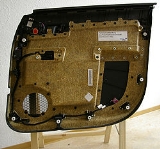
Biocomposite
Encyclopedia

Extracellular matrix
In biology, the extracellular matrix is the extracellular part of animal tissue that usually provides structural support to the animal cells in addition to performing various other important functions. The extracellular matrix is the defining feature of connective tissue in animals.Extracellular...
(resin
Resin
Resin in the most specific use of the term is a hydrocarbon secretion of many plants, particularly coniferous trees. Resins are valued for their chemical properties and associated uses, such as the production of varnishes, adhesives, and food glazing agents; as an important source of raw materials...
) and a reinforcement of natural fibers (usually derived from plants or cellulose
Cellulose
Cellulose is an organic compound with the formula , a polysaccharide consisting of a linear chain of several hundred to over ten thousand β linked D-glucose units....
). With wide-ranging uses from environment
Natural environment
The natural environment encompasses all living and non-living things occurring naturally on Earth or some region thereof. It is an environment that encompasses the interaction of all living species....
-friendly biodegradable composites to biomedical composites for drug/gene
Gene
A gene is a molecular unit of heredity of a living organism. It is a name given to some stretches of DNA and RNA that code for a type of protein or for an RNA chain that has a function in the organism. Living beings depend on genes, as they specify all proteins and functional RNA chains...
delivery, tissue engineering applications and cosmetic orthodontics
Orthodontics
Orthodontics, orthodontia, or orthodonture is the first specialty of dentistry that is concerned with the study and treatment of malocclusions , which may be a result of tooth irregularity, disproportionate jaw relationships, or both...
. They often mimic the structures of the living materials involved in the process in addition to the strengthening properties of the matrix that was used but still providing biocompatibility, e.g. in creating scaffolds in bone tissue engineering. Those markets are significantly rising, mainly because of the increase in oil price, and recycling
Recycling
Recycling is processing used materials into new products to prevent waste of potentially useful materials, reduce the consumption of fresh raw materials, reduce energy usage, reduce air pollution and water pollution by reducing the need for "conventional" waste disposal, and lower greenhouse...
and environment necessities.
Biocomposites are characterised by the fact that:
- the petrochemical resin is replaced by a vegetable or animal resin, and/or
- the bolsters (fiberglassFiberglassGlass fiber is a material consisting of numerous extremely fine fibers of glass.Glassmakers throughout history have experimented with glass fibers, but mass manufacture of glass fiber was only made possible with the invention of finer machine tooling...
, carbon fibre or talcTalcTalc is a mineral composed of hydrated magnesium silicate with the chemical formula H2Mg34 or Mg3Si4O102. In loose form, it is the widely-used substance known as talcum powder. It occurs as foliated to fibrous masses, its crystals being so rare as to be almost unknown...
) are replaced by natural fibre (wood fibres, hempHempHemp is mostly used as a name for low tetrahydrocannabinol strains of the plant Cannabis sativa, of fiber and/or oilseed varieties. In modern times, hemp has been used for industrial purposes including paper, textiles, biodegradable plastics, construction, health food and fuel with modest...
, flaxFlaxFlax is a member of the genus Linum in the family Linaceae. It is native to the region extending from the eastern Mediterranean to India and was probably first domesticated in the Fertile Crescent...
, sisalSisalSisal is an agave that yields a stiff fibre traditionally used in making twine, rope and also dartboards. The term may refer either to the plant or the fibre, depending on context...
, juteJuteJute is a long, soft, shiny vegetable fibre that can be spun into coarse, strong threads. It is produced from plants in the genus Corchorus, which has been classified in the family Tiliaceae, or more recently in Malvaceae....
...)
In biomaterials, it is important that each constituent of the composite be biocompatible. Moreover, the interface between constituents should not be degraded by the body environment. Normally, Bio-composite material can be classify in to three groups
- Particulate Composites
- Fibrous Composites
- Porous Materials
External links
- Discussion on physical-chemical properties of biocomposites
- Example and photo of a sandwich biocomposite manufactured with a wood/fabric hemp matrix and 20% PU resin The resulting material combines high resistance and low weight, with bending modulus of 9000MPa and a density 0,5 T/m3.
- www.kareline.fi thermoplastic injection moulded biocomposites

